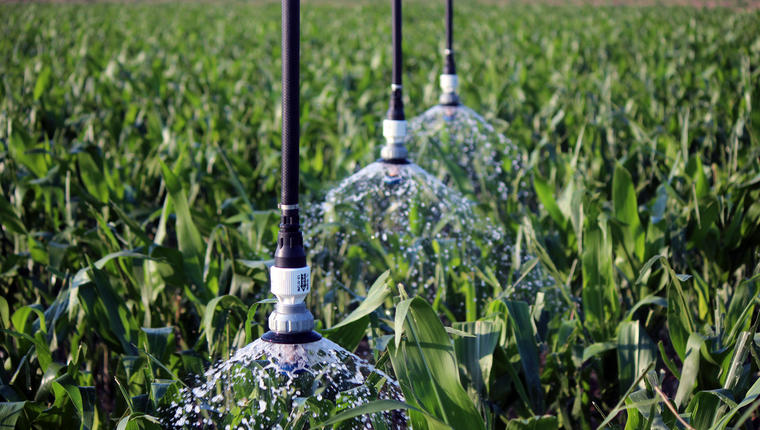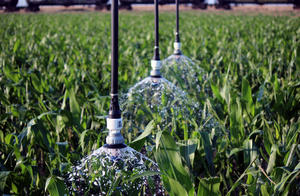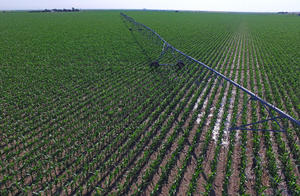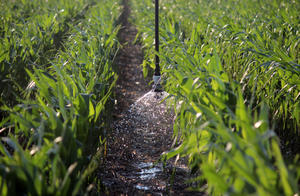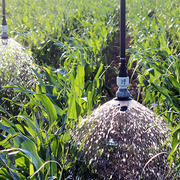
Agricultural Irrigation
LEPA Bubbler Helps Kansas Farmer Reduce His Water Usage and Slash His Maintenance Costs
Location:
Holcomb,
KS
United States
Profile
Holcomb,
KS
United States
Crop
Soybeans, Corn and Wheat
Soil Type
Tight silt clay loam
Sprinkler Height
1-3 ft (30-92 cm)
Spacing Between Sprinklers
30 inches (76 cm)
Dwane Roth of Holcomb, Kansas shares why the LEPA Bubbler is part of his farm succession plan for irrigating long into the future.
The Challenge
The Ogallala aquifer has had a 70 ft (21.3 m) decline in the past 10 years, and it is drying up fast. Dwane Roth farms near Holcomb, Kansas and partially depends on the aquifer for his irrigation water.
“We all have a responsibility to use the most precious resource the best that we can.” Dwane said. “We have a responsibility to ourselves and our next generations; to get the most efficient use of water we can for future generations.”
Improving his irrigation efficiency is a challenge though. The farm is in an area with incredibly low humidity levels, high temperatures in the 100 to 105⁰ F (37.7 to 40.5⁰ C) range, and 40 to 45 mph (64.3 to 72.4 kmh) winds.
The Solution
Dwane began questioning if there is anything more he could do to improve his pivot irrigation efficiency when his farm manager asked him if there was better technology available. He believed he was doing the best he could, but the question encouraged him to research alternative technologies.
This research led him to the LEPA Bubbler and the work done at the Kansas Water Office with Water Technology Farms.
Dwane then turned his operation into a water technology farm in partnership with the Kansas Water Office (K-State) and converted his pivots to LEPA Close Spacing technology.
He installed the LEPA bubblers at 30 inch (76 cm) spacing and tested them at heights ranging from 1 to 3 ft (30 to 91 cm) above the soil. “All variations seem to be working pretty good,” he said. “We’re eliminating the evaporation that is on the leaves. We’re putting the water where the roots are taking it up.”
He also installed soil moisture probes to track the success of the bubblers. The soil moisture probes also help him determine if a pivot needs to be sped up, slowed down, or if it needs to run at all.
The Result
Kansas has a 14.9-inch (37.8 cm) irrigation requirement for corn. With the soil moisture probes helping him better time his irrigation, and with the LEPA bubbler fighting evaporation loss, he can get the requirement down to 12 inches (30.4 cm) and still grow over 200 bushels.
“It is substantial how the bubblers can actually help us reduce irrigation, but actually increase the efficiency of it; on how the plant is taking up water from it.” He said. The decreased evaporation losses were “the big kicker right there,” he added. It also did not matter whether he planted in circles or rows. The bubbler helped lower his irrigation water usage either way.
Dwane also has less wear and tear on his pivots thanks to the LEPA Bubbler’s more concentrated application. This has helped dramatically reduce his maintenance costs. “We’ve actually been able to design the spacing good enough around the wheel track,” he said. “We put the bubbler out wide enough, so we don’t have a wheel track anymore. It’s staying off the motor so we’re keeping the water completely off the tower.”
The bubbler has now become an important part of his succession plan. He believes that with this technology he will be able to irrigate long into the future.
Photo Gallery
Installed Products
Installed Products
Copyright © 2024 Senninger®. All rights reserved. Privacy Policy
Back to Top
